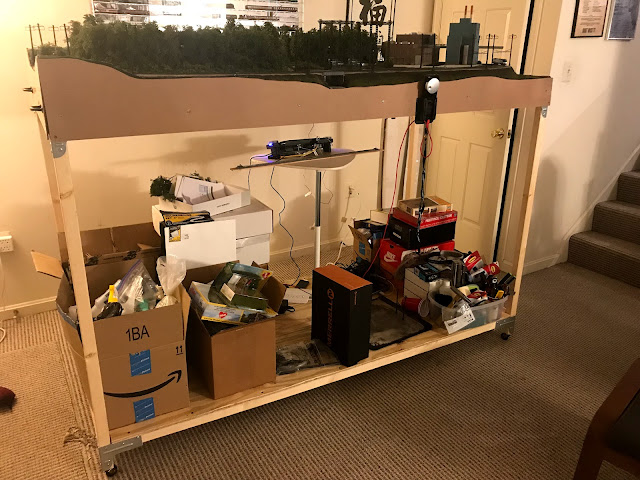Rode this in Canada when I was 10 or 11, and Rapido did it right in N scale. Thanks Jason Shron, and company, this one hits the spot.
Model railroadin' and trains. . . the South Shore line, mostly, but anything electric or Northeast Corridor or Northwest Indiana turns up here
Monday, November 26, 2018
Monday, November 19, 2018
Ahh, the Utah Belt
Eric Brooman's Utah Belt is featured--again, after a sufficiently healthy interval--in the December 2018 Model Railroader. Even though I'm not particularly interested in modeling a southwestern US class 1 railroad, I have always enjoyed seeing the UB. I enjoy the artistry--Eric is an art teacher, after all. The vistas are unmistakably the great southwest, and Eric has nailed the colors, textures, and composition.
I also admire the depth and maturity of the overall concept. The UB *looks* right, like it belongs in the panoply of big American railroads. The paint scheme, in particular, is conservative, and UB's rolling stock conforms to consistent themes.
I also admire the depth and maturity of the overall concept. The UB *looks* right, like it belongs in the panoply of big American railroads. The paint scheme, in particular, is conservative, and UB's rolling stock conforms to consistent themes.
Monday, November 12, 2018
Retrofitting New Benchwork Under the Old Line Corridor
Also, the folding metal legs' springiness and tiny feet made it difficult to move the layout--moving the layout or even adjusting its position required two strong adults to lift the layout straight up.
I cribbed the idea for the folding metal legs from several different Model Railroader magazine project layouts. In particular, the Carolina Central layout from the mid 90s demonstrated the exact approach I used on the OLC. The Carolina Central had used a narrower 30" door and significantly less foam insulation than the OLC. As a result, I suspect the OLC's larger 36"-wide foot print and 3-plus inches of foam might have been pushing the limit of the extended folding legs' capacity.
I considered a variety of options for replacing the folding legs. One approach would have borrowed another Model Railroader idea, that which was used under Red Oak N scale project layout: a heavy wheeled cart constructed from 1x4s and L-girders. Another would have been to use Ikea Ivar shelf components, as has has been done by Marty McGuirk and Bernie Kempinski on their layouts.
I homed in on a 2x2-based approach using Simpson Strong Tie shelving hardware. A Simpson Strong Tie DIY Shelving kit provided the eight required fittings and an ample supply of screws to attach the fittings to 2x2s. The fittings were attached at the top and bottom of the 48" 2x2 uprights. A 36" x 80" panel of 1/2" plywood, with 1 1/2" notches cut into the corners, formed a shelf for the bottome of the new frame. Once the fittings and plywood shelf were completely screwed in, the new frame was very rigid and strong. Casters with 3/8" stems were then fitted to the legs. The resulting benchwork is appropriately lightweight, yet rigid. The casters allow the layout to be repositioned and moved around the room easily.
And the wobble is completely gone!
Monday, November 5, 2018
N Scale Toaster Update
 |
| Getting ready for prime time: over in the paint shop, the Shapeways/Imperial AEM-7 shells have received a coat of GSI/Creos Mr. Surfacer. Note that the bottom half of the loco's pilots have been removed to accomodate the truck-mounted couplers. The coat of paint revealed prominent stratification and other artifacts of the 3D printing process. I anticipate that several coats of Mr. Surfacer, with careful sanding and polishing in between coats, will be required before they are ready for finishing in Amtrak colors. One will get an as-delivered Phase III paint scheme; the other will be finished in the Phase V scheme, which these Toasters wore at the time of their retirement. |
Subscribe to:
Comments (Atom)



